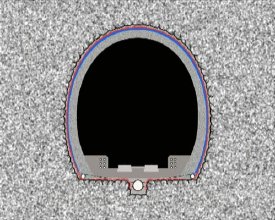Oct 18 2010
Among those celebrating the breakthrough of the longest rail tunnel in the world on October 15th 2010 were Empa engineers and researchers. Their task was to ensure that the tunnel remains dry for the next hundred years – quite a “job of the century” in itself!
The Gotthard base tunnel, cut through a mantel of rock up to 2,500 meters thick, and currently the longest railway tunnel in the world, forms the core of the NRLA, the New Rail Link through the Alps. Deep in the mountain rock harsh conditions prevail. In conjunction with the enormous pressure and rock temperatures of up to 45°C, groundwater seepage can inflict severe damage on the tunnel itself and railway equipment. Tunnel builders therefore had to find new ways of allowing the water to drain away at atmospheric pressure, thus keeping the tunnel interior dry. What was required was the best sealing and drainage system (SDS) available in synthetic material, which would allow the tunnel – a two layer construction with an outer shell of sprayed shotcrete surrounding the load bearing inner layer of concrete – to be built as designed.
 Sealing a tunnel to prevent the ingress of groundwater at high pressure is no easy task. In the NRLA tunnel the drainage system of a shotcrete outer shell, drainage material (red), sealing surface (blue) and load-bearing concrete inner shell must have a service life of about 100 years.
Sealing a tunnel to prevent the ingress of groundwater at high pressure is no easy task. In the NRLA tunnel the drainage system of a shotcrete outer shell, drainage material (red), sealing surface (blue) and load-bearing concrete inner shell must have a service life of about 100 years.
Simulating the conditions in a test gallery
The materials used are expected to have a service life of about 100 years. However, there is no long term data on the materials available today which would allow reliable predictions of service life on this scale. Therefore, on behalf of AlpTransit, the consortium responsible for constructing the tunnel, Empa investigated the suitability of various different systems. In order to simulate the environment in the tunnel, the Empa researchers exposed the sealing systems under test to a wide range of harsh conditions
For example they subjected the SDS candidate materials to temperatures of up to 70°C in alkaline, acid and oxygen-rich water for 24 months, and they were also subjected to attack by aerobic and anaerobic microorganisms. To test their resistance to pressure the sealing materials were clamped between a smooth and a rippled pressure plate and submerged in an alkaline solution. After just six months the first signs of degradation became apparent in some of the individual materials tested. As a result, a second set of tests were necessary to identify the most suitable material combinations.
The trials went a step further by subjecting large area samples not just to tensile and compressive loads but also to lateral shear. To simulate the elevated rock temperature and the effects of groundwater seepage the test apparatus was equipped with a heating system as well as a clever water circulation system which enable the drainage capacity to be measured.
And finally, to observe the behavior of the materials when laid under building site conditions, the Empa team fitted various sealing systems in a test gallery, concreted them in place and after conducting drainage tests, uncovered them again. Because of the waviness and roughness of the shotcrete, in combination with the number of anchoring points, folds occurred in the sealing surfaces, which might lead to cracking with time due to the high strains placed on the materials.
Innovation for the tunnel drillers
In the course of the project, the industrial partners time and again drew on Empa’s experience and research results to help develop new, more robust temperature and oxidation resistant material systems with increased compression stiffness and ageing resistance. This led not just to progress in welding techniques but also to a new method of joining the waterproof membranes using flexible Velcro® style hooks and loop fasteners instead of with fixed washers. A solution was also found to the “folding” problem.
Simultaneously other Empa scientists have also been making sure that the diesel vehicles used in the tunnel construction emit less health-damaging exhaust gases. Their work on improving catalytic particle filters was recognized by the award in 2009 of the Sandmeyer Prize, the most important Swiss research prize in applied chemistry.